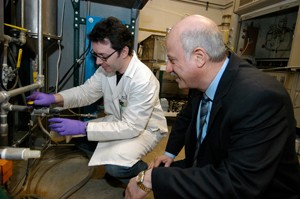
UC Jumpstarts Charge of Educating Future Energy Workforce
As attention throughout the United States and the world focuses on solving the energy crisis, the nations universities are charged to develop programs that will deliver researchers who can solve these energy problems and graduates who can work on the engineered solutions. One university is ahead of the pack: the University of Cincinnati (UC).
UCs College of Engineering and Applied Science has created the
nations first baccalaureate undergraduate degree program in energy and materials engineering (EME)
and is now accepting applicants.
No field is more vital to our countrys economic expansion than energy the ability to generate, store, distribute and utilize energy efficiently, says Makram Suidan, director of the School of Energy, Environmental, Biological and Medical Engineering, which will house the EME program.
EME graduates will be able to apply their skills to a variety of engineering and scientific careers in fields as diverse as aerospace, automotive, nanotechnology, medicine, biotechnology and energy. Selected core course topics include fuel cells, solar power generation and photovoltaic cells, hydrogen production and storage, carbon management and environmental impact, energy economics and conservation, batteries and storage, wind and geothermal, fossil power generation, bio-fuels /algae, nanomaterials and energy systems.
U.S. Secretary of Energy Secretary and Nobel Laureate Steven Chu was recently quoted as saying, alternative and renewable energy [will] reduce our dependence on foreign oil and create millions of new jobs.
President Obama, in his
of tax credits for the clean-energy manufacturing sector, said, Building a robust clean energy sector is how we will create the jobs of the future jobs that pay well and cant be outsourced. But its also how we will reduce our dangerous dependence on foreign oil, a dependence that endangers our economy and our security. And it is how we will combat the threat of climate change and leave our children a planet thats safer than the one we inherited.
Yet Undersecretary of Energy Kristina Johnson, in a follow-up videoconference, noted that one of the main problems facing the United States at the same time is a brain drain in the form of an aging workforce who were drawn into energy careers during the energy crisis of the 1970s. Those idealists
of
the 60s and 70s are now workers
in
their 60s and 70s who are about to retire.

Governor Ted Strickland enjoyed test driving UC's soy-fueled Jeep on a 2007 visit.
Forty to sixty percent of the energy workforce will retire in four years, Johnson stated.
And in the Midwest, as pointed out in Governor Ted Stricklands
address, Ohio is leading the way.
I believe in Ohio because we are not sitting back and letting other states pass us by, Strickland said. We are taking the vital next steps to
advance our energy economy
.
UCs program in
Energy and Materials Engineering
meets these challenges with contemporary curriculum and cooperative work assignments highlighted by green energy technologies centered on innovative materials and alternative energy sources. Students will study an array of topics including diverse energy production, conversion and storage opportunities covering fossil fuels, nuclear, wind, solar, water, geothermal, biomass and chemical sources. Each presents its own set of technical, environmental and economic challenges.
This program will produce a student who understands the gamut of energy issues: traditional, advanced, alternative, green and storage, says Suidan.

Co-op students worked with Duke Energy at Zimmer Power Plant. (Photo by Lisa Ventre)
As with UCs other engineering programs, all EME students participate in co-op program beginning as early as the winter quarter of their second year.
The University of Cincinnati founded cooperative education in 1906
and its co-op program is ranked in the top five nationally. Through co-op, students gain paid, professional experience working as engineers while still enrolled as undergraduates. A minimum of four co-op quarters must be completed for graduation.
Suidan is excited about the new program, especially given parallel pushes in the Obama administration to solve the nations energy problems.
This 21st century degree ensures that graduates have the background and engineering expertise to immediately address todays and tomorrows energy and materials challenges.
Related 2009 UC News Releases:
Governor Ted Strickland and the Ohio Board of Regents name nine centers of excellence at eight universities across Ohio.

Professor Vesco Shanov explains the concept of race cars powered by proton exchange membrane fuel cells to student Elizabeth Morris. (Photo by Dottie Stover)
The New Energy Crisis: Power Industry to Need Workers
In the current economic climate where job losses only seem to grow, the latest energy industry predictions show that utilities and power plants face a significant worker shortage by 2013.
[pdf]
Related Stories
UC engineer applying generative AI to smart manufacturing
March 31, 2025
Manish Raj Aryal, a PhD student in mechanical engineering at the University of Cincinnati, is working on revolutionizing manufacturing systems through generative AI, leveraging AI systems to develop manufacturing assistant chatbots. He came to UC for his master's degree and continued researching as a PhD student. He was named Graduate Student Engineer of the Month by the College of Engineering and Applied Science (CEAS).
Exploring careers in robotics engineering: A path to the future
March 28, 2025
Discover robotics engineering careers: skills, paths, and opportunities in manufacturing, healthcare, and space. Explore salaries and how to start at UC’s CEAS.
Mechanical engineering student helps send science to the moon...
March 28, 2025
UC student Ilyas Malik aids Firefly's lunar mission for NASA's CLPS. Explore his journey, UC's co-op impact, and aerospace insights. Discover how education transforms career paths in space exploration.
